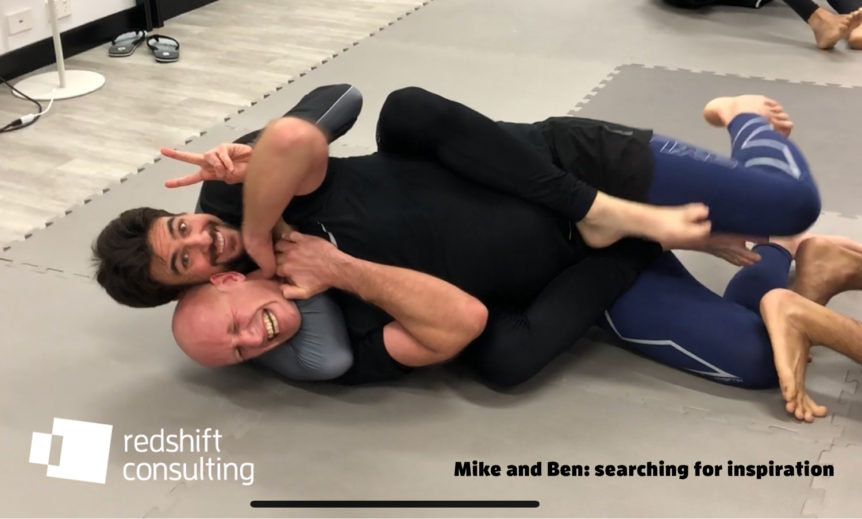Welcome back to our Customer Discovery series. This is a series written for executives, business owners, and transformation practitioners who are interested in improving their chances of discovering new markets or discovering new products for new markets that customers will actually buy.
The focus this week is on outlining the approach, asking you to make some guesses, and hopefully getting you off your laptop and out into the community, where you can find the answers to your search.
The actual approach I use is grounded by the work of Steve Blank and isn’t particularly complicated, and it doesn’t require any special software or tools. But what it does require is talking to people. And, unfortunately for most executives and founders, it’s one of their biggest hurdles.
There are several ways you can arrive at the on-ramp of customer discovery. I’m not going to go into all of those entry points here, but I will start us off with one of my personal favourites.
For our starting point, let’s just assume you were strangled unconscious by a brand-new white belt while training in Jiu-Jitsu last night. When you finally woke up, she was standing over you, lifting your feet in the air to get the blood back into your brain. At that very moment, the lights turned back on, and the idea came to you. Hover Prams! Smooth, easy to turn, and a dream to push. And yes, Jiu-Jitsu is one of the sources of industry-leading innovation (at least for me, anyway…although more so when I’m the one administering the strangle).
So, you wake up and it comes to you. The perfect solution to Pram Drama. Well, maybe it is, maybe it isn’t. We’ll soon find out. Let’s assume you have what you believe to be the perfect solution to a problem. You’ve read my other articles, and you’ve realised that you want to do some customer discovery to find out if this idea can be turned into a real product and sold to real people for real money.
To kick things off, let’s begin with a free collaborative tool based on the business model canvas proposed by Osterwalder. We are only going to look at the right side, specifically the boxes for Value Propositions, Customer Segments, and Channels. The reason we are doing this is because you need to articulate your thoughts, ideas, and guesses. It is the guesses that we’re going to take out into the community to test.
To start with, list your guess for the Value Proposition. This is your product-problem hypothesis. It’s helpful to think about the Value Proposition as a job that your product or service is performing for a customer. Customers want to get jobs done, and they look to products and services within the market to accomplish these jobs. Christensen has a pretty good YouTube explanation of jobs here.
In the job search, there are basically two things that customers are trying to accomplish: they are either trying to remove/reduce pain, or they are trying to gain pleasure. Here is another video by Christensen where he shares a story about why people hire milkshakes. If you’re familiar with his milkshake story, then you might already be thinking to yourself, “Ah, this is a good example of how a customer might hire a milkshake to avoid pain.” And if that’s what you thought, you’re on the right track.
Next, jot down your guesses on the Customer Segments. This is important because its going to help you aim your laser beam at the right customers once you hit the pavement. You don’t need to go crazy with this on your first go. But definitely list your guesses for who you think are the most important customers and what their archetypes might look like. A few sentences are fine to get you going.
After you knock out the Customer Segments section, jump over to the Channels box. The Channel is just the way in which you think your customer wants to be reached: phone, email, in person, etc. Again, a couple sentences will be fine to start with.
If you are an executive or business owner, you can share this link with one of your leads, and the two of you can make a plan for heading outside. Having already fleshed out your guesses makes getting outside much easier. It also gives those working with you a much clearer picture of what you hope to accomplish. And yes, I’m serious: executives need to leave the building. No, it is not a waste of time. An hour outside will do you good.
Okay, nearly there. You should already have a guess from your Segments and Channels sections as to who your customers might be and where to find them. For instance, you already know you’re going to walk through the mall around 11 am and search for stay-at-home parents with young children in prams. Your framework should look something like this:
Clearly frame the customers’ pain points and the job they’re searching for.
- Who is experiencing it?
- When are they experiencing it?
- Who are they with?
- Where are they experiencing it?
- What is happening when they experience it?
- What device/technology are they currently using?
And so on…
Once you’re armed with that picture of the time and space where you think the customer experiences their pain point, grab a notepad and jot down a very simple script of questions to ask.
And no, you cannot simply walk up to people and ask, “Hey mate, what are your issues?” They’ll probably think you’ve either just walked out of—or are currently headed to—your local psych ward. Don’t ask me how I know.
The script should only have a few questions because you will probably be chatting with people for less than five minutes. Unless, of course, you are organising formal intake sessions where you intend on sitting down with people for 30–60 minutes. There is a time and place for that, but for the first couple of passes my advice is to just find a way to get in front of people and start a five-minute conversation. You’ll know in an hour or so whether or not it’s worth investing another minute in this idea.
When you approach people, be friendly, smile. I usually tell my team to use a method called PEST Control for building rapport with strangers—you need to control for these things, or you will be a pest: Posture, Eye Contact, Smile, Touch. Although, I don’t advocate randomly walking over and touching people—it’s weird. And be sensitive to the culture. Touch could simply be a pat on the shoulder after you’ve been chatting for a minute.
I’m not going to give you specific questions to ask. The questions you ask are totally dependant on your hypotheses. But I will say that your script should have an intro, and you should plan on weaving your questions casually into the conversation like in the following example. Remember, at this stage, think of it as nothing more than a friendly conversation.
[Posture] [Eye contact, Smile]
“Wow, is that a quadruple-decker pram? That’s amazing, I’ve never seen one of those!”
[Smile]“Have you had it long?”
Expand
“What’s it like to turn this thing?”
Expand on any pain points about effort to turn, weight, radius, etc.
Leading Statement:
“Yeah, my partner and I have two small kids, so we were thinking of upgrading…”
Tactical Silence: Let them break the silence—they will.
Expand on any issues/pain points, etc.
Playback
“Well, it sounds like this pram has heaps of space, but the turning radius is bit of a nightmare and it doesn’t fit through any doors, elevators, escalators, or even warehouse roller doors.”
Etc.
“I wonder if anyone’s ever thought of a way to deal with the issue of width or weight?”
Tactical Silence
“Yeah that sounds like an interesting idea… or I wonder if teleportation makes more sense. Of course, doing something like that could cost $100 or more.”
Tactical Silence
“Interesting, alright, well happy shopping.”
[Smile, Touch]Essentially what we are doing here is exploring the pain points that we guessed about previously to find out if they even matter to people. We are testing for awareness: are they aware of the problem? And then we are testing for solution readiness: are they ready for a solution and to what extent? Their response may tell us they’ve been searching for a solution, they’ve trialled something, or maybe they need a solution right now but haven’t been able to find anything, and they’ve been budgeting for it for the last 22 months.
Again, this is first-pass stuff. It’s about quickly generating some momentum and trying to discover whether or not you even have a solution worth exploring.
Next week we will expand on this further, and I’ll share an example from one of my own discovery sessions with a Sydney dentist and show how a simple discovery session turned into a major product breakthrough.
Until next time –

Mike is the Founder and General Manager of Redshift Consulting, Founder of Praetorian Code, and Board Member to the International Business TRIZ Association. He holds a Masters in Innovation and Entrepreneurship (UMD) and a Bachelors in Psychology and Education (UCSB). He is a Certified Lean Six Sigma Black Belt (UTS); Certified Practitioner of Theory of Inventive Problem Solving (TRIZ); former US Army Ranger and a Brazilian Jiu-Jitsu fanatic.

